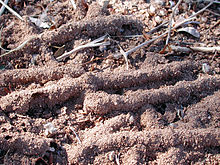Amitermitinae
| Amitermitinae Temporal range:
| |
|---|---|

| |
| Dry twigs covered with soil by feeding activities of encrusting termites, Gnathamitermis perplexus in the Sonoran Desert, Arizona | |
| Scientific classification | |
| Domain: | Eukaryota |
| Kingdom: | Animalia |
| Phylum: | Arthropoda |
| Class: | Insecta |
| Order: | Blattodea |
| Infraorder: | Isoptera |
| Family: | Termitidae |
| Subfamily: | Amitermitinae Kemner, 1934 |
| Genera | |
|
Ahamitermes | |
Amitermitinae is a disputed subfamily of "higher termites" now often merged with the subfamily Termitinae[1] and is considered by ITIS as a synonym;[2][3] it had previously been placed in the family Rhinotermitidae.
Amitermitinae have as typical characteristics: a usually rounded head with a bilobed clypeus. The mandibles of their soldiers usually has a single median tooth.
They have evolved the ability to have many reproductives in their colony, up to a hundred, which allows very large colonies. As with other members of their family, Termitidae, they have lost most of their cellulose-digesting protozoa. Instead, they eat fungi, which digest cellulose and other organic matter. As a result, the Termitidae can make use of a wide variety of foods; not only rotten wood, but also grass, seeds, dung, soil, and detritus [4][5] are all used by one species or another. In addition, some species can synthesize nitrogen compounds.[6]
Many members of the Amitermitinae have evolved a very effective way of securing food. The Amitermes species especially build a shell of earth by cementing the earth with their saliva and use it to cover vegetation. This smothers the plant and they can then eat the fungi that grow in the safety of the covering. They probably evolved in savanna, monsoon, and desert regions because their runways are not very resistant to rain erosion[7] They use saliva to build runways, and this is an adaptation of an earlier use of saliva to entangle enemies [8]
The cemented soil is richer in phosphorus than the soil from which it is derived.[9] This causes an increased loss of phosphorus from sheet erosion. It is probably a major part of the reason why tropical savanna soils are depleted in phosphorus, especially in Australia. The genus Termes branch probably arose in Africa.[10] The Amitermitinae are thought to have arisen in Southeast Asia,[10] probably from primitive Oriental Termitinae species,[11] in early Cretaceous[12] but it may be even more likely in Australia, since that is where phosphate deposits were clustered in the late Jurassic and early Cretaceous.[13] The primitive Amitermitinae species are most numerous in those regions at present. The development of at least 25 fundamentally different sesquiterpenes and several unique cyclic ethers for termite defense in the Amitermitinae [14] hint at considerable success and large numbers in the early years for such systems must be elaborate to evolve.
References[edit]
- ^ Termite Catalogue (retrieved 13 July 2019)
- ^ ITIS
- ^ Moriya Ohkuma; Hiroe Yuzawa; Weerawan Amornsak; Yupaporn Sornnuwat; Yoko Takematsu; Akinori Yamada; Charunee Vongkaluang; Quab Sarnthoy; Nit Kirtibutr; Napavarn Noparatnaraporn; Toshiaki Kudo; Tetsushi Inoue (May 2004). "Molecular phylogeny of Asian termites (Isoptera) of the families Termitidae and Rhinotermitidae based on mitochondrial COII sequences". Molecular Phylogenetics and Evolution. 31 (2): 701–710. doi:10.1016/j.ympev.2003.09.009. PMID 15062804.
- ^ MacKay WP (1991) The role of ants and termites in desert communities. p113-150 in; Polis GA ed. The Ecology of Desert Communities. University of Arizona Press, Tucson.
- ^ Hill GF (1942) Termites (Isoptera) from the Australian Region. HE Daw, Govt. printer, Melbourne, Australia.
- ^ Schaefer DA Whitford WG (1981) Nutrient cycling by the subterranean termite Gnathitermes tubiformans in a Chihuahuan desert ecosystem. Oecologia 48; 277-283.
- ^ Weber CE (1993) Cretaceous termites and soil phosphorus. J. Soil Biol. Ecol. 13; 108-121.
- ^ Noirot CH (1969) Glands and secretions of termites p89-119 in; Biology of Termites. Krishnar K Weesner M, ed. Vol I, Academic Press NY.
- ^ Weber CE (1993) Cretaceous termites and soil phosphorus. J. Soil Biol. Ecol. 13; page 111.
- ^ a b Emerson AE (1955) Geographical origin and dispersions of termite genera. FieldianaZool. 37; 465-521; p. 478
- ^ Krishna K (1970) Taxonomy, phylogeny, and distribution of termites p127-150 in: Biology of Termites, Vol II Krishna K & Weesner FM, eds. Academic Press NY.
- ^ Bouillon A (1970) Termites of the Ethiopian region, in; Biology of Termites. Krishna A Weesner FM eds. Academic Press, NY.; p. 162
- ^ Cook PJ (1984) Spatial and temporal controls on the formation of phosphate deposits- a review P242-274; page = 251; map in; Phosphate Minerals. Nriagu JO Moore PB eds Springer Verlag Berlin NY.
- ^ Prestwick GD (1983) The chemical defenses of termites. Sci. American 249; pp. 78-87.
